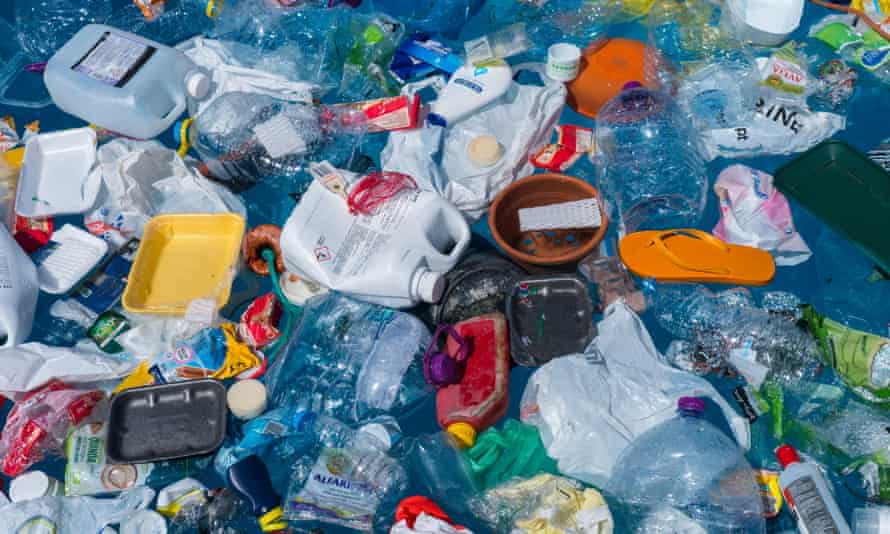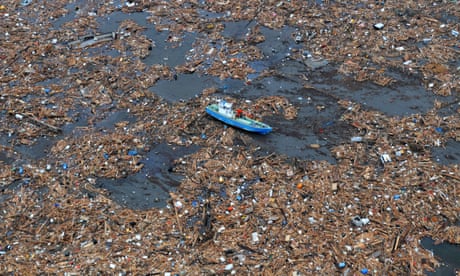Ocean plastic has created a unique home for specialised organisms, from animals that travel on it to bacteria that ‘eat’ it

Plastic floating in the ocean. An estimated 1m plastic bottles
reach the sea every minute.
Photograph: Paulo Oliveira/Alamy
Russell Thomas
Wed 11 Aug 2021
Plastic bottles dominate waste in the ocean, with an estimated 1m of them reaching the sea every minute. The biggest culprit is polyethylene terephthalate (Pet) bottles.
Last month, a study found two bacteria capable of breaking down Pet – or, as the headlines put it, “eating plastic”. Known as Thioclava sp. BHET1 and Bacillus sp. BHET2, the bacteria were isolated in a laboratory – but they were discovered in the ocean.
The bacteria are the latest example of new organisms that appear to be growing in a unique environment: the vast amounts of plastic at sea.
Like the atmosphere, magnetosphere and hydrosphere, the plastisphere is a region. But it is also an ecosystem, like the Siberian steppe or coral reefs – a plasticised marine environment. The best-known concentration of seaborne plastic waste is the Great Pacific garbage patch, a sort of plastic soup spread over an area roughly twice the size of France, but plastic is everywhere.
First described in a 2013 study to refer to a collective of plastic-colonising organisms, including bacteria and fungi, the term has since expanded. It now loosely encompasses larger organisms, from crabs to jellyfish, which raft across oceans on marine plastics.
The term was coined by Linda Amaral-Zettler, a marine microbiologist at the Royal Netherlands Institute for Sea Research.

Plastic rafting: the invasive species hitching a ride on ocean litter
“In 2010, we were planning to collect plastic samples for an upcoming cruise to characterise the biofilms [organisms that stick to each other and other things] on plastic,” says Amaral-Zettler. “I was trying to think of a convenient term to describe the community and came up with […] ‘plastisphere’.”
Although the term may be recent, the phenomenon is not. “The plastisphere has been around for as long as plastic has existed,” Amaral-Zettler says.
What is new is our understanding of just how complex an ecosystem the world of plastic can be. In the plastisphere there are organisms that photosynthesise; there are predators and prey; symbionts and parasites, allowing for “a full gamut of interactions possible, as in other ecosystems”, says Amaral-Zettler.
“If we take the definition of an ecosystem as ‘a biological community of interacting organisms and their physical environment’, then this is almost certainly true of the plastisphere,” says Robyn Wright, of the pharmacology department at Dalhousie University in Canada, and author of the June study.
Another unique feature of the plastisphere is that humans invented it. Every other ecosystem has evolved over millions of years. The meaning of that is not yet clear.
“I don’t think it’s necessarily important that it’s not natural in origin, because all of the members of the plastisphere are still ‘natural’, but it’s more an issue of scale,” Wright says. Unlike most naturally occurring materials, plastic is highly durable and persistent, allowing the growth and spread of attached organisms over a massive area.

Plastic waste floating off the French coast.
Photograph: Boris Horvat/AFP/Getty Images
Additionally, a study last year discovered that certain colours of plastic affected the diversity of the microbes colonising them: communities on blue microplastics had a richer diversity than those on yellow or transparent plastics.
There are also concerns about plastic-colonising organisms that can travel around the world. Amaral-Zettler’s 2013 study discovered Vibrio, a type of bacteria known to contain several species of pathogens, including some associated with gastroenteritis.
Though there is potential for the plastisphere to harbour pathogens, Wright is sceptical. “There isn’t really any concrete proof that plastics pose any more danger than any other surface that bacteria colonise, or any other area of the environment,” she says.
For the scientists, the plastisphere’s sheer presence is a less obvious concern than its potential health hazards. Most plastic ends up in landfill, but nearly a third of it ends up in the sea. The majority sinks, but a lot does not, becoming a home for all sorts of microbes that might not otherwise have a home.
The bacteria move in because when plastics are submerged in water they attract carbon, iron, nitrogen and phosphorus, which in turn attracts microbes. This is sometimes called the Zobell effect, after the marine microbiologist Claude E ZoBell.
[Microbes on] plastics are going to be the key place to look in the fight against plasticRobyn Wright, researcher
What happens then is largely unknown.
“At the moment that’s still very much an active area of research,” Wright says. There are two main fields of investigation: potential pathogens in the plastisphere, and the potential for some microbes to biodegrade hydrocarbons, such as the plastic-eaters identified last month.
Those are not unique to the ocean. In 2016, scientists in Japan discovered Ideonella sakaiensis, a species of bacteria at a rubbish tip that had evolved an enzyme that enabled it to eat plastic.
But another study in the same year found that, compared with bacteria in the surrounding waters, those in the plastisphere possessed an enriched collection of genes, suggesting that they had adapted for a “surface-attached lifestyle”.
Scientists caution that it’s important not to think of these as recent mutants.
“While plastics are a relatively new material on an evolutionary timescale, the chemicals that they’re made from aren’t new – mainly constituents of oil,” Wright says. “Bacteria have therefore had millions of years to develop mechanisms to degrade the chemicals that they’re made from.”
Could the plastisphere evolve in such a way that bacteria would essentially eat it, or at least help us identify ways to break down our plastic waste? “I’d definitely agree that [microbes on] plastics are going to be the key place to look in the fight against plastic,” says Wright.
Additionally, a study last year discovered that certain colours of plastic affected the diversity of the microbes colonising them: communities on blue microplastics had a richer diversity than those on yellow or transparent plastics.
There are also concerns about plastic-colonising organisms that can travel around the world. Amaral-Zettler’s 2013 study discovered Vibrio, a type of bacteria known to contain several species of pathogens, including some associated with gastroenteritis.
Though there is potential for the plastisphere to harbour pathogens, Wright is sceptical. “There isn’t really any concrete proof that plastics pose any more danger than any other surface that bacteria colonise, or any other area of the environment,” she says.
For the scientists, the plastisphere’s sheer presence is a less obvious concern than its potential health hazards. Most plastic ends up in landfill, but nearly a third of it ends up in the sea. The majority sinks, but a lot does not, becoming a home for all sorts of microbes that might not otherwise have a home.
The bacteria move in because when plastics are submerged in water they attract carbon, iron, nitrogen and phosphorus, which in turn attracts microbes. This is sometimes called the Zobell effect, after the marine microbiologist Claude E ZoBell.
[Microbes on] plastics are going to be the key place to look in the fight against plasticRobyn Wright, researcher
What happens then is largely unknown.
“At the moment that’s still very much an active area of research,” Wright says. There are two main fields of investigation: potential pathogens in the plastisphere, and the potential for some microbes to biodegrade hydrocarbons, such as the plastic-eaters identified last month.
Those are not unique to the ocean. In 2016, scientists in Japan discovered Ideonella sakaiensis, a species of bacteria at a rubbish tip that had evolved an enzyme that enabled it to eat plastic.
But another study in the same year found that, compared with bacteria in the surrounding waters, those in the plastisphere possessed an enriched collection of genes, suggesting that they had adapted for a “surface-attached lifestyle”.
Scientists caution that it’s important not to think of these as recent mutants.
“While plastics are a relatively new material on an evolutionary timescale, the chemicals that they’re made from aren’t new – mainly constituents of oil,” Wright says. “Bacteria have therefore had millions of years to develop mechanisms to degrade the chemicals that they’re made from.”
Could the plastisphere evolve in such a way that bacteria would essentially eat it, or at least help us identify ways to break down our plastic waste? “I’d definitely agree that [microbes on] plastics are going to be the key place to look in the fight against plastic,” says Wright.

Ideonella sakaiensis is a recently discovered bacterium that has the potential to ‘eat’ plastic waste. Illustration: Dr_Microbe/Getty/iStockphoto
But though Amaral-Zettler admits that some microbes can indeed feed off already UV-degraded plastic, she cautions against overstating the possibilities.
“It is important to realise that studies that look at plastic-‘eating’ bacteria only provide these bacteria with a single source of carbon,” she says. “This is in contrast to what is found in nature.”
Lab studies also do not take into account oceanic conditions, explains Wright, such as different temperatures, weather or the presence of other organisms. “But,” she adds, “even just knowing that this is theoretically possible is a really great step in the right direction.”
Just like our own gastrointestinal microbiome, which is massively important to our overall health, the plastisphere’s microbiome also has “an important role to play”, says Amaral-Zettler. Since we have modified our planet to the extent that these microbes have evolved to fit our plasticised oceans, understanding the new ecosystem we seem to have accidentally created is crucial.
“For better or for worse, like plastic,” she says, “the plastisphere is here to stay.”
But though Amaral-Zettler admits that some microbes can indeed feed off already UV-degraded plastic, she cautions against overstating the possibilities.
“It is important to realise that studies that look at plastic-‘eating’ bacteria only provide these bacteria with a single source of carbon,” she says. “This is in contrast to what is found in nature.”
Lab studies also do not take into account oceanic conditions, explains Wright, such as different temperatures, weather or the presence of other organisms. “But,” she adds, “even just knowing that this is theoretically possible is a really great step in the right direction.”
Just like our own gastrointestinal microbiome, which is massively important to our overall health, the plastisphere’s microbiome also has “an important role to play”, says Amaral-Zettler. Since we have modified our planet to the extent that these microbes have evolved to fit our plasticised oceans, understanding the new ecosystem we seem to have accidentally created is crucial.
“For better or for worse, like plastic,” she says, “the plastisphere is here to stay.”
No comments:
Post a Comment